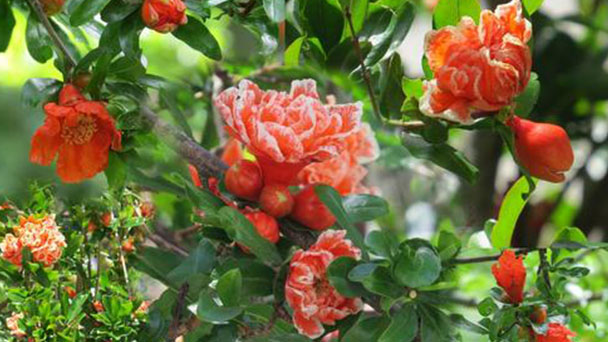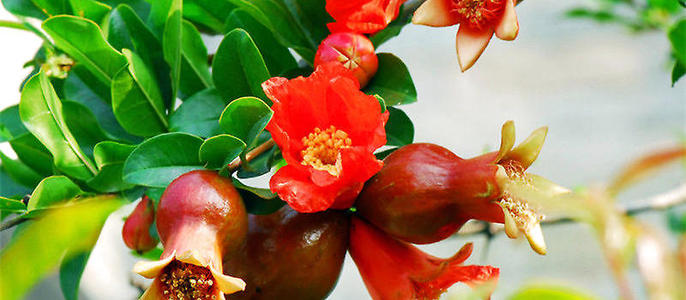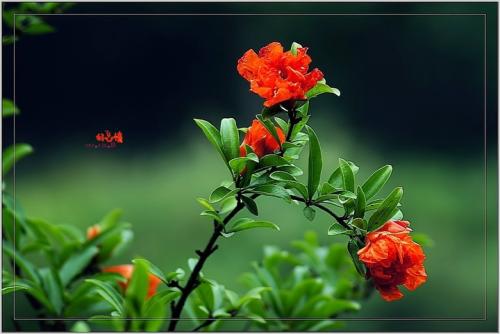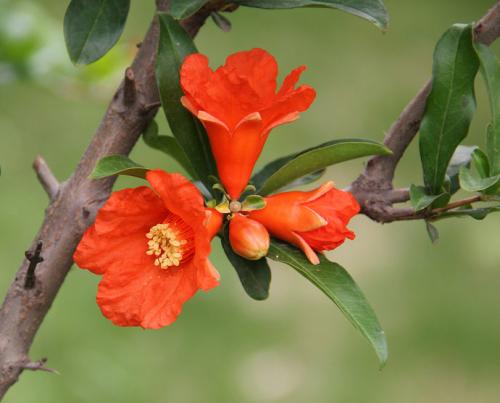Pomegranate flowers profile
Written by Maggie
Jan 11 2021

Pomegranate flowers are unisexual, and there are male and female flowers on a tree, both of which are beautiful.The male flowers are small at base, obtuse triangular at sides, and fall off after flowering; The female flowers are conspicuously enlarged at the base (as seen when flowering), and only the female flowers bear fruit.
Pomegranate flowers are deciduous shrubs or small trees. Plant height is 2-5m, up to 7m. The trunk is grayish brown, flake peeling, twig yellow green smooth, often four prism, branch tip is spiny, no terminal bud. Leaves are simple opposite or clustered, orbicular or obovate, 2 -- 8cm long, entire, glossy, short stipitate, young green or bronzed. Flowers to several on branch apex or leaf axil; Flowers are bell-shaped, fleshy, apically 6-lobed, smooth and waxy, orange-red, persistent. It has 4-7 petals, red or white, single or double.
Pomegranate flowers picture

Features of Pomegranate flowers
Stems
Pomegranate flowers are the flowers of the deciduous shrub or small tree pomegranate flowers (Punica granatum). The height of Pomegranate flowers is 2 ~ 5m, and the highest can reach 7m. Pomegranate flowers have flaky peeling, green and yellow shoots are smooth, often four-prism, most of the branches are spiny, no terminal bud.
Leaf
Leaves are simple opposite or clustered, rounded or obovate, 2 -- 8cm long, entire, smooth, short stalked, bright green or bronzed new.
Flower
Few flowers are on top of branches or axils, bell-shaped, fleshy, 6-lobed, smooth, waxy, orange-red, persistent. Pomegranate flowers have 5-7 petals, red or white, single or double.
Pomegranate flowers are unisexual, and there are male and female flowers on a tree, both of which are beautiful. The male flowers are small at base, obtuse triangular at sides, and fall off after flowering; The female flowers are conspicuously enlarged at the base (as seen when flowering), and only the female flowers bear fruit.
Pomegranate flowers bloom in June and July.
The fruit
Pomegranate flowers have globular yellow - red berries. Seeds are most with a fleshy outer seed coat, 9 ~ October fruit ripe. Pomegranate flowers can be divided into two categories: fruit and flower.
The fruit of Pomegranate flowers ripens in September and October.
Pomegranate flowers habits
Pomegranate flowers are tolerant to cold, drought, waterlogging and shade. They are not strict with soil. It is best to choose fertile, loose and nutritious sandy loam soil.
Pomegranate flowers propagation method
Pomegranate flowers are commonly propagated by cuttings, splitting and layering. When cutting, choose biennial branches in spring or use semi-lignified branches in summer that can be inserted, rooted 15-20 days after insertion. Separate plants can be in early spring in April bud initiation, dig robust root tiller seedling points.
Slath can be carried out in spring, autumn, and does not have to cut injury, before bud initiation with root part tillering pressure into the soil, after the summer rooting cut from the mother plant, autumn is into seedlings.
Open cultivation should choose the place with sufficient light and good drainage. In the process of growth, it is necessary to remove the roots and tillering seedlings and cut off the dead branches, sick branches, dense branches and long branches for the sake of ventilation and light.
Potted Pomegranate flowers should be shallow, and we need to control watering. It should be dry, not wet. In the growing period, we need to pick the heart, control the growth of vegetative branches, and promote the formation of flower buds.

Prevention of diseases and pests of Pomegranate flowers
The main occurrence of leaf blight and gray mold, can be used 70% methyl tobutin wettable powder 1000 times the liquid spray. Insect pest has thorn moth, scale insect and aphid harm, with 55% kill borer pine emulsion 1000 times liquid spray kill.
Pomegranate flowers main usage and value
Pomegranate flowers have both considerable flowers and fruit. Small pot plants are used for windowsills, balconies and bedroom furnishings. Large pot plants can be used to decorate public places and meeting places.
As a medicine, Pomegranate flowers have a long history and are recorded in various ancient medical books.
Through clinical practice, doctors of all dynasties believe that Pomegranate flowers are cool in nature and have the effects of clearing away heat, detoxifying, strengthening stomach, moistening lung, astringent intestine and hemostasis.
Pomegranate flowers growing methods
It is more ornamental to choose varieties with beautiful fruits and flowers, such as pink sweet Pomegranate flowers, agate Pomegranate flowers, white Pomegranate flowers, red-shell Pomegranate flowers, four-season Pomegranate flowers and soft-seed Pomegranate flowers.
The selection of pots: Wooden barrels, wooden boxes, the diameter of the basin mouth 30-40 cm, 30-35 cm deep. Nutrient soil preparation: leaf leaf soil or humus soil 7, turf soil 2, sand soil 1. All kinds of soil will be broken and sifted, mixed evenly, stacked, spread branches or other flammable material on top, lit, not only increase the plant ash, but also play a role in high temperature treatment of the soil.
Transplant seedlings into the pot in the middle and late March. Before planting the pot bottom drainage hole with tiles pad, the pot bottom filled with part of the nutrient soil, the seedlings into the pot, covered with soil cultivation, with the hand to slightly lift the seedlings up a few times, pouring permeable, after the water seepage and then covered with soil. The fill should be 5cm below the edge of the basin. Then place the basin in a sunny place to increase humidity and promote root growth.
Pleasant fertilizer should be applied when planting, and organic fertilizer should be applied after falling leaves in autumn and winter. Quick effect fertilizer should be applied once before leaf growth, flower management and after falling flowers. Due to the limited soil in the pot, the amount of fertilizer applied each time should not be too much, so we should "eat less and eat more". The commonly used fertilizer is mainly organic fertilizer such as cake fertilizer, which is fermented and added with liquid fertilizer.
The characteristics of tight branches and dense leaves, dormant period can be a thinning pruning, can be cut into a single round head, can also be cut into a multi-stem cluster or flat top type.
In case of dry rot or coal stain, the infected branches can be cut off and burned.Peach borer was the main pest, which was sprayed 50% dichlorvos 500-1000 times during egg hatching. From early June to early July, the larvae were sprayed with 2000 times solution to kill thrin before caries, and other leaf-eating pests were also treated. After fruit setting, 5 grams of phoxim emulsion can be used for 500 grams of dry fine soil, adding appropriate amounts of water to prepare medicine mud, for prevention and control.
In winter, place potted Pomegranate flowers in a sunny room at a room temperature of no more than 5℃ to maintain normal dormancy.
Pomegranate flowers flower language
Flower language: Mature beautiful rich descendants full of prosperity.

Latest Updated
- Benefits of Bugleweed - 7 Science-backed Health Benefits
- Bugleweed Dangers & Side Effects - Is It Poisonous?
- How to Plant Evergreen Trees - What You Should Know
- When to Plant Evergreens - Grow Guide for Evergreen Trees
- 12 Wonderful Evergreen Shrubs for Your Garden
- 12 Popular Evergreen Plants with Pictures for Beginners
- When And How To Prune A Lilac Bush Like a Pro
- How to Grow & Care for Lilac Vine (Hardenbergia Violacea)
- Japanese Lilac Tree (Syringa Reticulata) Care & Propagation Guide
- Shumard Oak Pros and Cons - What to Know
Popular Articles
- Winter maintenance of Antirrhinum Majus
- How to Grow Terminalia Mantaly Tree
- How to Grow and Care for Crossostephium Chinense
- How to grow Antirrhinum Majus in spring
- Peristeria Elata (Dove Orchid) Profile: Info & Care Guide
- Underwatered Snake Plant (Sansevieria Trifasciata) - Signs And How To Fix
- How to Care for Brazilian Jasmine Plant (Mandevilla Sanderi)
- How to Grow & Care for Graptopetalum Purple Delight in Summer
- Rosa Chinensis (China Rose): Plant Growing & Care Tips
- How to Care for Baby Sun Rose (Aptenia Cordifolia)